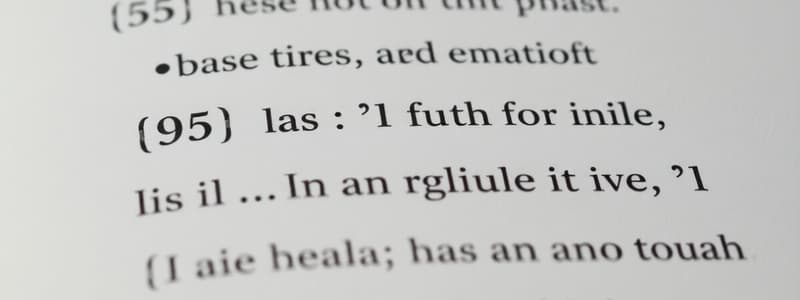Podcast
Questions and Answers
Match the punctuation mark with its primary function in a sentence:
Match the punctuation mark with its primary function in a sentence:
Colon (:) = To introduce a list or emphasize a point Semicolon (;) = To connect two independent clauses Ellipsis (...) = To indicate an omission of words or a pause Hyphen (-) = To link words forming a compound adjective before a noun
Match the punctuation mark with its function:
Match the punctuation mark with its function:
Apostrophe (’) = Indicates possession or omitted letters in contractions Quotation Marks (“”) = Enclose direct quotations or indicate sarcasm Exclamation Point (!) = Expresses strong emotion or emphasis Question Mark (?) = Indicates a direct question
Associate each sentence ending punctuation mark with its appropriate context:
Associate each sentence ending punctuation mark with its appropriate context:
Period (.) = End a declarative sentence or an indirect question Question Mark (?) = End a direct question Exclamation Point (!) = End a sentence with strong emotion Ellipsis (...) = Indicate a trailing thought or omitted information
Match each punctuation mark with its purpose in structuring a sentence:
Match each punctuation mark with its purpose in structuring a sentence:
Match the punctuation mark to whether it is a terminal or pausing point:
Match the punctuation mark to whether it is a terminal or pausing point:
Connect each punctuation mark with its function in indicating pauses or breaks in text:
Connect each punctuation mark with its function in indicating pauses or breaks in text:
Match each punctuation mark with its role in creating compound words or indicating omitted letters:
Match each punctuation mark with its role in creating compound words or indicating omitted letters:
Match the punctuation mark with its function in direct speech:
Match the punctuation mark with its function in direct speech:
Associate each punctuation mark with its specific function related to lists or series:
Associate each punctuation mark with its specific function related to lists or series:
Match each punctuation mark with examples of it's usage in a sentence:
Match each punctuation mark with examples of it's usage in a sentence:
Match the punctuation mark to its general category:
Match the punctuation mark to its general category:
Match each punctuation mark with its role in indicating a pause or omission:
Match each punctuation mark with its role in indicating a pause or omission:
Match each sentence ending punctuation mark with its appropriate end usage:
Match each sentence ending punctuation mark with its appropriate end usage:
Match the term to its definition:
Match the term to its definition:
Match the quotation with the punctuation rule it follows: “Can you please stop that tapping?” I asked.
Match the quotation with the punctuation rule it follows: “Can you please stop that tapping?” I asked.
Match the purpose to the example:
Match the purpose to the example:
Match the suffix usage to the base word:
Match the suffix usage to the base word:
Match each contraction with its purpose:
Match each contraction with its purpose:
Match the punctuation to what it relates to:
Match the punctuation to what it relates to:
Match the situation of ellipsis to what the meaning represents:
Match the situation of ellipsis to what the meaning represents:
Flashcards
Period (.)
Period (.)
To end a statement or after an indirect question.
Comma (,)
Comma (,)
To make a pause between thoughts and to list things.
Colon (:)
Colon (:)
To introduce a serial list, or to emphasize a point.
Semicolon (;)
Semicolon (;)
Signup and view all the flashcards
Question Mark (?)
Question Mark (?)
Signup and view all the flashcards
Exclamation Point (!)
Exclamation Point (!)
Signup and view all the flashcards
Quotation Mark (“”)
Quotation Mark (“”)
Signup and view all the flashcards
Apostrophe (‘)
Apostrophe (‘)
Signup and view all the flashcards
Ellipsis/Ellipses (…)
Ellipsis/Ellipses (…)
Signup and view all the flashcards
Hyphen (-)
Hyphen (-)
Signup and view all the flashcards
Terminal points
Terminal points
Signup and view all the flashcards
Pausing points
Pausing points
Signup and view all the flashcards
Study Notes
- Study notes on punctuation marks and their uses
Period (.) / Full Stop
- Used to end a statement.
- Used after an indirect question.
- Used when abbreviating a name.
Comma (,)
- Used to make a pause between thoughts.
- Used to list items.
- Used when quoting someone.
Colon (:)
- Used to introduce a serial list.
- Used to emphasize a point.
Semicolon (;)
- Connects two separate but related thoughts.
- Joins independent clauses in a sentence.
Question Mark (?)
- Ends "Yes" or "No" questions.
- Expresses uncertainty or confusion.
- Used at the end of direct questions.
- Question marks go inside quotation marks when they are part of the quoted text.
Exclamation Point (!)
- Shows emphasis or emotion in a written sentence.
- Emphasizes interjections.
- Expresses strong commands.
Quotation Mark (“”)
- Used to quote someone.
- Indicates a skeptical or mocking tone.
Apostrophe (‘)
- Used to show possession.
- Replaces omitted letters in a contraction.
Ellipsis/Ellipses (…)
- Shows an omission of words.
- Represents a pause.
- Suggests something is left unsaid.
- Used to cut out irrelevant parts of a quote.
Hyphen (-)
- Links two or more words that describe a noun.
- Used in numbers between twenty-one and ninety-nine.
- Used for fractions used as adjectives.
- Used to join prefixes and suffixes to base words, especially for clarity.
Punctuation Mark Groupings
- Terminal points end sentences: Periods, Question marks, Exclamation points.
- Pausing points indicate pauses: Commas, Colons, Semicolons, Ellipses.
Studying That Suits You
Use AI to generate personalized quizzes and flashcards to suit your learning preferences.




